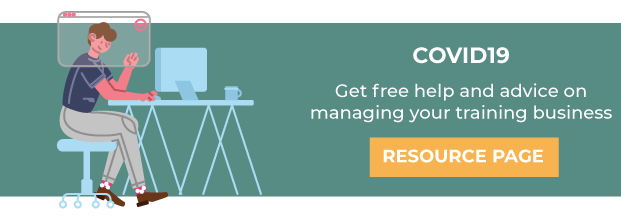6 Ways Training Providers Can Bounce Back Stronger Post-COVID

COVID-19 has changed the training landscape dramatically. From the way we deliver training to the way we communicate with colleagues, the only constant right now is change itself.
Some training providers have been able to grow their business during COVID-19, whilst others have been forced to close and re-evaluate. Whatever position your training business finds itself in currently, we've got some actionable tips on how you can come back stronger than ever.
- Right People, Right Seats
- Perfect The Process
- Audit Technology
- Enhance Your Offering
- Reevaluate Company Goals
- Optimise Online Presence
Right People, Right Seats
With the vast majority of training professionals working from home, this presents a great opportunity for a time of reflection, both personally and professionally. In order to bounce back stronger, you need to first ensure you're getting the best out of your most important assets, your staff.
'Right people, right seats' is a phrase used regularly within the EOS framework - a set of concepts and tools to help leaders get the most from their entrepreneurial business.
The 'right people' refers to each of your staff members being an appropriate fit for your training organisation. Outside of their job role and performance, do they align with your company values? And more importantly, do your company values actively reflect who you are and your company purpose?
Right person, Wrong seat |
Right person, Right seat |
Wrong person, Wrong seat |
Wrong person, Right seat |
'Right seat' is slightly more complex. Of course, if it's the 'wrong person' (someone who doesn't fit your company values) it doesn't matter if they're in the right seat, they aren't a great fit for your business.
However, the 'right person' in the wrong seat is where progress can be made. You know they're a good fit for you, it's just about finding something more appropriate for their skill set.
With that in mind, it's perhaps time to consider that the old organisational structure chart complete with job titles may need a bit of a rethink. If a staff member leaves and your instant reaction is to re-hire for the same position, perhaps it's time for a change. When planning for a post-COVID world, consider the following:
- What roles are most important to the business? Are there any that are now redundant?
- Do our job descriptions match what we now expect of our staff?
- Are we playing to the strengths of our staff?
You may even find that your employees skill sets match a different role much better.
Happy, one of accessplanit's customers, provide a great example of this. Henry Stewart, Chief Happiness Officer at Happy says they rip up the job specification once they take on a new member of staff, instead finding out what they're good at. This is mentioned in the below video along with a number of other ways to get the most from your staff and cater for their well being during COVID-19.
It's important to consider, there's hundreds of skilled workers within the training industry that are currently looking for new employment following redundancy from COVID, that could add some valuable expertise and fresh ideas to your business. They may even be able to fit a role that hasn't been invented yet.
This extends beyond just your employees, too. If you work with any agencies, freelance trainers and other external support - what value are you getting? Do they all have a role to play in your post-COVID plans?
Perfect The Process
Perhaps even before you assess company structure and personnel, it's worth knowing if what you're doing is effective. Defining your processes may even determine what your organisational structure is going to look like. By processes, we are referring to:
Internal processes: The things that happen behind the scenes, within an organisation
External processes: The things your customer experiences and their journey with you
Internal processes
Processes make up everything we do. The cost to the business of ineffective or outdated processes can hinder our ability to remain competitive, and leave staff completing unfulfilling and time consuming tasks in their day-to-day. Internal processes can be anything from how you record a new lead to registering a HR concern.
Improving internal processes focuses on one thing: efficiency gains. If you can streamline how you currently do things, any time savings can be reinvested into areas that drive results.
A few examples of where to start include:
- Asking your staff: Get some honest answers on what tedious, repetitive things burden their day to day. There's a fair chance they'll have some solutions in mind themselves. It may even require a fresh pair of eyes, perhaps using the expertise of an external consultant.
- Record it: If you've identified an area where time savings could likely be made, establish how long it's currently taking to carry out each task. Could this time be better spent?
- Defining a process and documenting it: Create a knowledge framework for the business that helps your team to align and allows remote working newbies to get up to speed quickly!
External processes
When your external processes are not in sync, your customers may receive inconsistent information, training sessions might have no structure, and there's often a lack of accountability and responsibility across your team. This is significant, when you consider that customer satisfaction is still seen as the number one criteria for success according to our annual training industry benchmark report.
Defining and aligning your external processes and having your whole organisation on board is crucial in order to bounce back stronger.
In the modern day, effective external processes rely on technology. Things like a CRM, a website and social media channels all contribute to the effectiveness of external processes, which brings us neatly onto the third point...
Audit Technology
Technology goes hand in hand with processes; we use technology to improve, simplify and streamline our processes.
There's a few different ways technology can help you to bounce back stronger.
- Using new technology
- Consolidating existing systems
- Getting more use out of current tech
- Cleaning up current systems
Using new technology
New technology for training providers could mean any number of things. It could be a management system such as a CRM, TMS or LMS. It could be a video creation tool. It could even be a social media platform you had once overlooked. Our annual benchmark report found 34% of training providers are now using Linkedin to network and promote their training offering.
The common misconception with modern tech is that it's always expensive, in reality there's tons of free software solutions out there that can aid your day to day operations. After you're up and running on the big 5 social media channels above, check out some free tools below:
Buffer - A tool that allows you to schedule social media posts across multiple platforms days in advance.
Canva - A graphic design tool that allows you to create professional graphics, presentations and poster with ease.
Loom - Video messaging for work. Create screen sharing videos with ease and send a link to colleagues
Trello - Task organisation made easy, with a drag and drop kanban board that can be shared with your team
Lusha - A lightweight plugin that allows you to easily find email addresses and additional company data of prospects
The great thing about the above tools is that they're essentially plug-and-play. You can be up and running in no time with zero support required.
There is a time and a place for investment, though. In order to achieve larger business objectives, you typically need the initial investment to be able to get a return on it. Whilst the above tools are great for specific tasks, things like a training management system can help you towards multiple business objectives in one - such as reducing costs, scaling your business and improving your customer journey. There are a range of other management systems on the market, it's just a case of finding the one that's right for you.
Consolidating existing technology
How many tools does your training organisations currently use? If this is something you've never mapped out, I'd suggest laying them all out in front of you.
Now, draw a line between the ones that integrate (can talk) with one another. Is this an efficient use of technology?
Don't get me wrong, you'll never find one system that does everything, nor is it practical to link up systems that have no common interest.
The problem arises when you find yourself in a 'web of chaos'. We're of course talking about disparate systems and their negative impact on a business.
A few things that indicate this may be an issue for your business include:
- Paying for multiple product license keys
- Relying on imports and exports of data
- Misalignment between platforms - 'multiple sources of truth'
COVID could present an excellent time to:
- See if there are any potential integrations that reduce manual intervention
- See if there is capabilities in System A to carry out the tasks you currently do in System B
- See if there's other technology that can bring everything into one place
Getting more use out of current tech
Modern tech is full of intricacies and complexities. This is to the extent where most of us actually use only a fraction of the functionality inside a given system.
Quite simply - we're paying for stuff we're not using.
Now is an excellent time to check in with that account manager that you've not spoken to in months, and see how you could be getting more out of your existing tech. It won't cost you a penny and may help you to reduce your reliance on other pieces of technology
Cleaning up current systems
When was the last time you exported data from your CRM and gave it a good old cleanup?
It's rarely a riveting task, but it's necessary in order to avoid the perils of bad data.
This process could involve:
- Ensuring user and account information is up to date
- Ensuring the communications you're sending are effective and triggering correctly
- Deleting old data that may even be in breach of GDPR
Enhance Your Offering
How do you feel about your course catalogue? Are your courses going to have the same relevance and appeal as pre-COVID?
When was the last time you drilled down into each of your courses and objectively measured how it's helping your business?
Assessing and analysing your courses is made easy if you have a robust reporting engine in place. By this, I mean your ability to report on the following
- Course feedback: Which course is highest rated among delegates? Is there a particular trainer that's stood out?
- Online interest: Which course page has generated the most clicks? Which course generates the most enquiries?
- Profitability: Where do you earn the most money? Which course or venue relies on minimal cost?
- Retraining opportunities: Where could you add an additional module or elearning content? Could you capitalise better on expiring awards?
- Upselling: Could you be making more money on this course? What could you sell that compliments the session? (eg. a textbook, access to a content library, a certificate)
If you find that one or two of your courses are either pricey to run, consistently receive poor feedback or are rarely enquired about by prospects, perhaps it's time to introduce something new.
You could start by:
- Analysing your competitors: Are they offering anything you aren't?
- Asking your clients: What would they like to be trained on?
- Trialling something new: Have you considered running taster sessions?
Whether it's improving an existing course, creating a new course or consolidating what you already have, these all have great potential in helping you to bounce back stronger.
Reevaluate Company Goals
If the current goals for your organisation are the same as the ones you set pre-COVID - then congratulations. You've likely been both proactive and resilient throughout COVID, or perhaps you haven't got round to addressing them yet! For most, its a time for honesty and a realistic outlook.
Unrealistic goals can have drastic consequences on your staff, especially if they see their KPI's drift as each week passes by, morale fading by the minute. Sure, goals that extend to more than a year in the future are perhaps pretty hard to predict right now, however laying out some short term milestones could be a good place to start.
The aim of setting fresh company goals during COVID-19 is to get your staff onboard, working towards a common objective as one. Check out our webinar below that has some other top business planning tips during COVID-19.
Optimise Online Presence
If there was ever a golden time to start that re-brand project you've been considering for a while...
Outside of a fully fledged re-brand, there's a number of things you could be changing, testing and analysing to see what both clients and prospects think about your business, starting with your website.
Here's some questions to consider:
- Is it easy for potential clients to understand what we offer?
- Is our booking/enquiry system working effectively?
- Where are people spending the most time on our site?
- Can people navigate our site easily?
- How is our web traffic looking?
Improving a website can include a number of different things - some much more simple and cost effective than others. Check out the table below for a few quick wins you can try out and improve on today.
| Website Change | Benefit | Task | Difficulty / Cost |
| Increase internal linking | Easier navigation across website | Add internal links to other relevant website pages | Easy / Free |
| Improve course description pages | More information for delegates to influence buying decision | Add more detail and increase appeal of offering | Easy / Free |
| Change homepage messaging | Find a more appealing message to draw clients in | A/B test different messages and test using Google Analytics | Easy / Free |
| Support pages for existing clients | Reassurance and transparency for clients | Educate on safety measures put in place and business opening hours | Easy / Free |
| Linking Google Analytics | Visibility over website traffic and source | Set up Google Analytics in no time and track your domain | Easy / Free |
| Page load speed | Reduce bounce rate and improve experience | Reduce image file sizes, consider Lazy loading | Easy / Free |
| Insert Call to Actions | Increase conversions by telling users what action to take | Implement HTML link from CRM or external tool to capture key data | Easy / Cheap |
Once you've made the necessary changes, it's worth thinking about how you can attract more traffic to your website.
If resource permits, the following can have a ground-breaking impact in terms of increasing web traffic:
- Content creation: Starting a blog, running webinars or creating gated content are all great ways to attract more visitors to your site.
- Search Engine Optimisation: SEO is the process of optimising your website in order to gain more, better quality leads. Things like gaining authoritative backlinks, producing quality content, implementing effective internal linking and page structure/design are all key factors in attracting organic traffic through search engines.
- Pay-per-click: Create adverts that put your website in front of a defined audience, typically paying either by impression or conversion.
- Email Campaigns: Attract new business and re-engage past customers using effective, targeted email campaigns to direct clients to content on your website.
- Social Media: It's time to get posting. Use multiple channels to your advantage, with catchy headlines and actionable advice in order to draw your clients in.
There we are. By using this time of uncertainty and change to shape up the future of your training business, you can help to add some structure, give your business a common goal and get your staff onside with the direction you're heading.
Let us know how you're preparing for the future in the comments below!
Related Resource
- 3 Ways: Taking Control Of Your Business During COVID-19
- Managing Motivation And Wellbeing For Your Staff During A Crisis
- [2020] Overcoming The 4 Biggest Challenges Facing Training Providers


.jpg?width=270&height=170&name=New%20Project%20(48).jpg)
